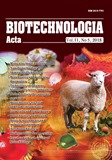ISSN 2410-7751 (Print)
ISSN 2410-776X (Online)

"Biotechnologia Acta" V. 11, No 5, 2018
https://doi.org/10.15407/biotech11.05.026
Р. 26-34, Bibliography , English
Universal Decimal Classification: 577.151
CALIX[4]ARENES METHYLENE BISPHOSPHONIC ACIDS EFFECT ON PLASMIN ACTIVITY
O. I. Yusova, O. V. Savchuk, T. Yatsenko, V. Popadiuk, L. G. Kapustianenko, T. V. Grinenko
Palladin Institute of Biochemistry of the National Academy of Sciences of Ukraine, Kyiv
The aim of the work was to study plasmin inhibiting properties of calix[4]arenes functionalized by phosphonic acid remnants. The following methods were used: turbidimetry, analysis of enzyme activity for chromogenic substrates, evaluation of caseinolytic activity for the release of tyrosine from casein, Dixon’s method for determining the type and inhibition constant. It was found, that calix[4]arenes С 296, С-425, С-427 and C-145 inhibit fibrin clot lysis by plasmin in dose-dependent manner and inhibition rate is proportional to the number of phosphonic acid remnants. C-145 is a most effective plasmin inhibitor (competitive mechanism, Ki = 0,52 ?M). However, C-145, as well as С-296, С-425 and С-427, does not affect amidolytic and caseinolytic plasmin activity but inhibit plasminogen activation by streptokinase. Thus, we assume that the mechanism of calyx[4]arene selectivity to fibrinolysis and its ability to obstruct plasminogen-streptokinase interaction is provided by complex formation between calix[4]arene negatively charged phosphonic groups and positively charged amino acids in substrate recognition exosites of plasmin. Calix[4]arene C-145 is effective plasmin fibrinolytic activity inhibitor and perspective for further investigation as antifibrinolytic agent.
Key words: fibrinolysis, plasmin, plasminogen, plasmin inhibitor, plasminogen activation, streptokinase
© Palladin Institute of Biochemistry of National Academy of Sciences of Ukraine, 2018
References
1. Waisman D. M. Plasminogen: Structure, Activation, and Regulation. Kluwer Academic Plenum Publishers: New York. 2003. https://doi.org/10.1007/978-1-4615-0165-7
2. Schousboe I. Factor XIIa activation of plasminogen is enhanced by contact activating surfaces and Zn2+. Blood Coagul. Fibrinolysis. 1997, 8 (2), 97–104. https://doi.org/10.1097/00001721-199703000-00003
3. Levy J. H. Pharmacologic methods to reduce perioperative bleeding. Transfusion. 2008, 48, 31–38. https://doi.org/10.1111/j.1537-2995.2007. 01574.x.
4. Al-Horani R. A., Desai U. R. Recent advances on plasmin inhibitors for the treatment of fibrinolysis-related disorders. Med. Res. Rev. 2014, 34 (6), 1–49. https://doi.org/10.1002/med.21315
5. Weinstein R. S., Roberson P. K., Manolagas S. C. Giant osteoclast formation and longterm bisphosphonate therapy. New Eng. J. Med. 2009, 360, 53–62. https://doi.org/10.1056/NEJMoa0802633
6. Suva L. J. Adjuvant bisphosphonates in breast cancer: the ABCSG-12 study. Curr. Osteoporos Rep. 2010, 8 (2), 57–59. https://doi.org/10.1007/ s11914-010-0012-5
7. Komisarenko S. V., Kosterin S. O., Lugovskoy E. V., Kalchenko V. I. Calixarene methylene bisphosphonic acids as promising effectors of biochemical processes. Ukr. Biochem. J. 2013, 85 (6), 106–128. https://doi.org/10.15407/ubj85.06.106
8. Shatursky O. Y., Kasatkina L. A., Rodik R. V., Cherenok S. O., Shkrabak A. A., Veklich T. O., Borisova T. A., Kosterin S. O., Kalchenko V. I. Anion carrier formation by calix[4]arenebis-hydroxymethylphosphonic acid in bilayer membranes. Org. Biomol. Chem. 2014, 12 (48), 9811–9821. https://doi.org/10.1039/c4ob01886a
9. Deutsch D. G., Mertz E. T. Plasminogen: purification from human plasma by affinity chromatography. Science. 1970, 170 (3962), 1095–1096. https://doi.org/10.1126/science.170.3962.1095
10. Smith G. F. Fibrinogen–fibrin conversion. The mechanism of fibrin-polymer formation in solution. Biochem. J. 1980, 185 (1), 1–11. https://doi.org/10.1042/bj1850001
11. Pozdnjakova T. M., Musjalkovskaja A. A., Ugarova T. P., Protvin D. D., Kotsjuruba V. N. On the properties of fibrin monomer prepared from fibrin clot with acetic acid. Тhromb. Res. 1979, 16 (1), 283–288. https://doi.org/10.1016/0049-3848(79)90292-5
12. Bouvier S. A., Beretta-Piccoli M., Giacometti N. Light scattering measurements of polymerization and depolymerization of fibrin: a tool for studying coagulation and fibrinolysis. In Progress in chemical fibrinolysis and thrombolysis. Davidson J. F., Ed. Raven Press: N.Y. 1975, V. 1, P. 281–288.
13. Vishwanatha K. S., Appu Rao A. G., Singh S. A. Characterization of acid protease expressed from Aspergillus oryzae MTCC 5341. Food Chem. 2009, 114, 402–407. https://doi.org/10.1016/j.foodchem.2008.09.070
14. Yoshino M., Murakami K. A graphical method for determining inhibition constants. J. Enzyme Inhib. Med. Chem. 2009, 24 (6), 1288–1290. https://doi>.org/10.3109/14756360902829766
15. Joshi K. K., Nanda J. S., Kumar P., Sahni G. Substrate kringle-mediated catalysis by the streptokinase-plasmin activator complex: critical contribution of kringle-4 revealed by the mutagenesis approaches. Biochim. Biophys. Acta. 1824 ,2012 (2), 326–333. https://doi.org/10.1016/j.bbapap.2011.10.010
16. Parry M. A., Zhang X. C., Bode W. Molecular mechanisms of plasminogen activation: bacterial cofactors provide clues. Trends Biochem. Sci. 2000, 25 (2), 53–59. https://doi.org/10.1016/S0968-0004(99)01521-2
17. Wang X., Lin X., Loy J. A., Tang J., Zhang X. C. Crystal structure of the catalytic domain of human plasmin complexed with streptokinase. Science. 1998, 281 (5383), 1662–1665. https://doi.org/10.1126/science.281. 5383.1662

